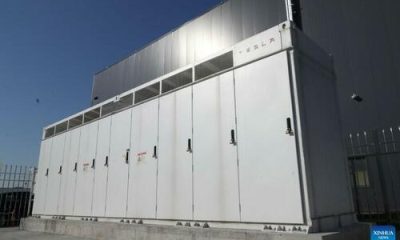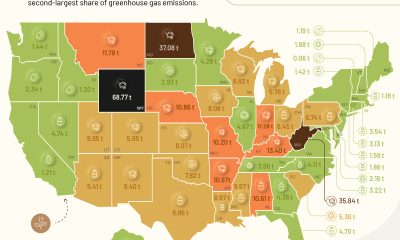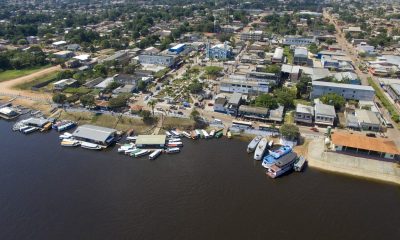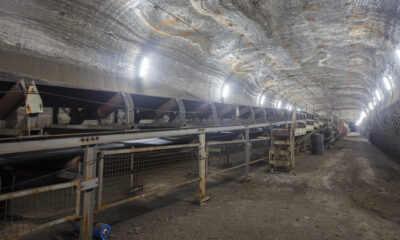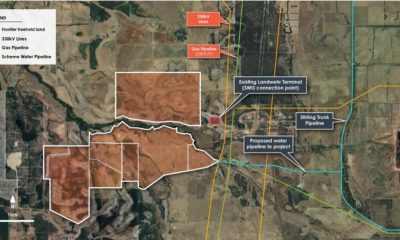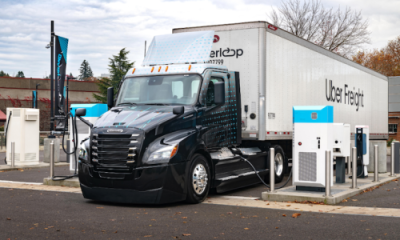Energy & Critical Metals
HIF Global, Porsche and Volkswagen Group unveil new direct air capture unit to be installed at eFuels plant in Chile in 2024
At the IAA Summit in Munich, HIF Global, together with Porsche AG, Volkswagen Group Innovation and MAN Energy Solutions, announced the development and…
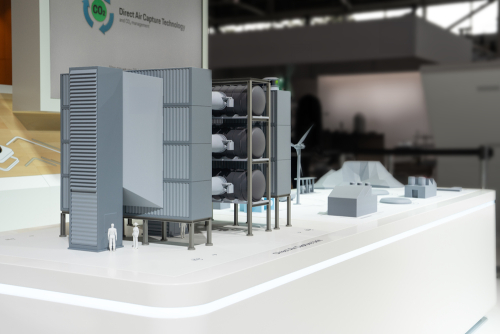
At the IAA Summit in Munich, HIF Global, together with Porsche AG, Volkswagen Group Innovation and MAN Energy Solutions, announced the development and installation of a Direct Air Capture (DAC) unit at the HIF Haru Oni Demonstration facility in southern Chile in 2024. (Earlier post.) HIF’s Haru Oni is the first fully integrated eFuels plant to test DAC technology.
We are not waiting for solutions to come to us; we are creating them and leading the way. We have proven carbon-neutral eFuels are a real solution to help decarbonize transportation. Now we are accelerating Direct Air Capture technology that enables efficient and low-cost CO2 capture—the future of CO2 recycling. We are very happy to be cooperating with Porsche to pioneer this unit in our facility in Chile and we hope to escalate this technology in the near future.
—President and CEO of HIF Global, Cesar Norton
eFuels are produced by combining green hydrogen and recycled CO2, obtaining eMethanol which is then converted into eGasoline, eSAF, or other synthetic fuels. MAN Energy Solutions provided the e-methanol reactor to the Haru Oni plant.
The Haru Oni facility is currently operating with biogenic CO2 and hydrogen produced with the strong winds of the Magallanes region. The DAC prototype comes as a supplementary solution, filtering up to 600 tons of carbon dioxide per year directly from the air.
The Volkswagen Group identified extracting CO2 from the atmosphere as an issue for the future back in 2019. Since then, we have extensively studied the concept with regard to suitable technologies and economic viability with international partners in the research and industrial sectors. Our research has found that scalable and commercially competitive direct-air-capture technology is possible. Together with Porsche and other partners, we now want to build a prototype plant and test the concept as a whole. We are already looking forward to the prospect of implementing this future-facing project in Chile.
—Nikolai Ardey, Director of Volkswagen Group Innovation
To slow global warming, it is essential to reduce emissions and remove CO2 from the atmosphere. At the same time, we need CO2 as a raw material in many production processes. Why not combine the two? We’re working on that. We want to put an industrial direct air capture, or DAC, procedure into series production. We regard DAC as a viable technology for the future because it can be used to extract the carbon molecules required for the production of many products in a sustainable manner. So, we are working on bringing the technology to a higher degree of maturity.
—Michael Steiner, Member of the Executive Board for Research and Development at Porsche AG
Earlier this year, HIF Global announced a complementary agreement with Baker Hughes to test their Mosaic DAC technology pilot units to accelerate DAC deployment at commercial scale. (Earlier post.) Acquired by Baker Hughes in April 2022 to enhance its carbon capture, utilization and storage (CCUS) portfolio, Mosaic Materials is focused on developing a proprietary direct air capture technology using Metal-Organic Framework (MOF) materials that can be used to separate CO2 from the atmosphere.
Mosaic’s technology, originally developed at the University of California, Berkeley, utilizes a cooperative binding process to produce highly selective MOF materials that require significantly less energy than competing technologies. This technology can be used to separate CO2 from nearly any gas mixture, from raw natural gas to recirculated breathing air.
Baker Hughes is leveraging its advanced capabilities, including modular design and material science, to develop and scale Mosaic’s innovative technology with the goal to enable direct air capture with higher efficiency and lower cost.
How direct-air-capture (DAC) technology works. To extract CO2 from the atmosphere, the ambient air is first cleansed of large dirt particles and directed through a pebble-like filter material. The CO2 deposited there is then extracted from the material and collected in a highly purified form for later use as a raw material. Water, a potential by-product, is drained off.
Model of a Direct Air Capture unit at the VW Group stand at the IAA Summit
This CO₂ extracted from the atmosphere can be used in a variety of different ways as part of a circular economy. In the future, it could be used as a raw material in the production of non-fossil-based plastics. This stores the CO2 long-term.
It can also be used to produce fully synthetic fuels, also known as eFuels. Porsche and HIF Global are studying whether and how DAC-extracted CO2 can be used at the Haru Oni eFuels plant in Punta Arenas, Chile, where CO2 is combined with hydrogen to form methanol. This is then made into synthetic fuel.
Haru Oni. In December 2022, eFuels company HIF Global, in which Porsche holds an interest, started industrial production of synthetic fuels at the Haru Oni pilot plant in Punta Arenas, Chile. Synthetic fuels enable potentially almost carbon-neutral operation of ICE vehicles. This is the case when it is manufactured from wind energy, renewable generated CO2 and hydrogen extracted from water.
In the plant’s pilot phase, eFuels production of around up to 130,000 liters per year is planned. Initially the fuel is to be used in lighthouse projects, such as in the Porsche Mobil 1 Supercup and at Porsche Experience Centers. Plans envision the construction of large plants near the pilot facility in Chile that would increase the production of eFuels over time.
The south of Chile offers ideal conditions for the production of eFuels, with significant levels of wind blowing for around 270 days a year and enabling wind turbines to operate at full capacity. Punta Arenas is also located close to the Strait of Magellan. From there, the synthetic eFuels can be transported just like traditional fuels using existing infrastructure.
Synthetic fuels can reasonably complement electromobility. Porsche has already invested more than US$100 million in the development and production of eFuels. Of that, US$75 million went to acquiring an interest in HIF Global LLC in April 2022. The company plans, builds and operates eFuels plants in Chile, Uruguay, the US and Australia.

Uranium Exploration Company Announces Additional Staking in the Athabasca Basin
Source: Streetwise Reports 12/22/2023
Skyharbour Resources Ltd. announced an update from its Canada-based Falcon Project along with additional…
Tesla Launches New Mega Factory Project In Shanghai, Designed To Manufacture 10,000 Megapacks Per Year
Tesla Launches New Mega Factory Project In Shanghai, Designed To Manufacture 10,000 Megapacks Per Year
Tesla has launched a new mega factory…
Giving thanks and taking stock after “a remarkable year”
An end-of-year thank you to our readers, industry colleagues and advertisers before Electric Autonomy breaks from publishing until Jan. 2
The post Giving…


